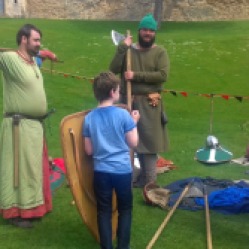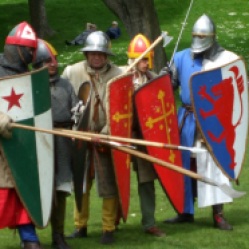I’ve written a few posts about visits and events connected to Lincoln Castle over the past couple of years, including the wonderful, German-style Christmas Market held annually in the castle grounds. But perhaps the most important events of recent years were in 2015, which focused on the 800 year anniversary of the signing of the Magna Carta by King John at Runneymede in 1215.

That Lincoln should become so involved with the Magna Carta anniversary is understandable, since one of only four of the remaining original documents from Runneymede is held at Lincoln Castle – on loan from Lincoln Cathedral. Two are held at the British Library and one at Salisbury Cathedral.
The Magna Carta anniversary involved lots of events throughout the summer in Lincoln, including the Barons’ Trail and the amazing sand sculptures displayed in the castle bailey. They all did wonders for tourism in the city and gave everything a very holiday feel.
This year, Lincoln is celebrating another anniversary, that of the Battle of Lincoln Fair (also known as the Second Battle of Lincoln) which took place in and around Lincoln Castle in 1217. This event is also linked to the infamous King John, even though he’d died the previous year.
This event is being held over two separate weekends and we went along to the first part yesterday, Sunday May 21. This one was held in the castle bailey and presented the preparations for battle. The second part, the actual reenactment of the battle itself, will be next weekend from Saturday to Monday, May 27-29 (Bank Holiday weekend here in the UK).
As with the Barons’ Trail of 2015, this anniversary is made fun for the city and its many visitors by having a Knights’ Trail throughout the central areas of the city. It’s a great activity for kiddies (and adults!) to hunt all 37 of the knights out. The knights are already in place, and we started photographing them yesterday. I hope to do a post about them all soon. The photo of Nicola de la Haye (or Nicholaa de la Haye, according to some sources) at the top of this post is one of them.
I don’t intend to do a full post about Lincoln Castle itself here: that’s set for a future date. But I’ll just say a little about it before I show photos of the event.
Lincoln Castle was built in 1068 on the orders of William the Conquerer. It stand on the site of the Roman fortress and settlement of Lindum Colonia (which dates from around AD60) in ‘uphill Lincoln’. This elevated position ensures the castle has commanding views of the surrounding countryside and can also be seen for miles – as can the nearby Cathedral. It is probable that, prior to the Roman fort, a Celtic settlement once occupied the site, which I’ll discuss another time.
The castle at Lincoln was one of the finest Norman castles in the country. It consists of an outer curtain wall (with an excellent Wall Walk along the top) along which are two gates – the East and West Gates, the former having a barbican, or fortified entrance. Three towers stand along the walls, two of them built on top of mottes (mounds or small hills, often man-made for the purpose). The two towers sitting on mottes are the Lucy Tower and the Observatory Tower, the one without a motte is Cobb Hall, at the north-east corner of the wall.
Inside the curtain wall is a large bailey (courtyard) in which there are three buildings of more recent origins. The first part of the Old Prison dates from 1788 and was completed in 1848. The Court House, which is still used today, dates from 1826, and the Heritage Skills Centre is a real baby, having only been officially opened in 2013. It’s the only new building within the castle walls for 150 years. It lies immediately behind the Law Courts:
Here are a few more photos of the castle, most taken from the Wall Walk. Some look down at the bailey, one or two at places beyond the castle, others along the wall itself:
I’ll save the detail and views inside the different towers for another time.
Tents and stalls were set up in the bailey for this event. Some of the attractions included ‘having a go’ at archery and instruction on the use and importance of the crossbow. A number of stalls showed foods and weapons of the time and there were birds of prey trained for hunting on display. We missed the actual presentation of the different birds of prey as we were up on top of the wall at the time. Still, we heard the falconer announce that he couldn’t allow the birds to fly at present because of the peregrines nesting on the cathedral – who would see his birds as competition and we could end up witnessing an airborne battle!
Here are a few photos of attractions and displays from around the Bailey, from ground level:
And here are a few of two of the demonstrations we watched. The fist was of knights (comically) preparing for battle.
The second was of three mounted knights displaying their skills in attacking their opponents – one of the ‘opponents’ being a cabbage, which represented the head of a Norman knight. 😀 The smaller of the three horses was included to demonstrate the type of horse/pony used prior to Norman times. It’s the type that was used by the Vikings and is the only breed to be found in Iceland today.
Finally, here are a few photos of Nicola de la Haye (the constable of the castle) and an episode with a French envoy who had come to persuade her to surrender the castle to the French invaders who intended to put their own Prince Louis on the English throne. In doing that, they would simply depose the son of King John – the nine-year-old Henry III. The French were supported in this by the barons who had rebelled against King John. Nicola adamantly refuses and, as the French have already landed in England, she prepares the castle garrison for forthcoming battle:
And absolutely lastly, the Battle of Lincoln Fair was named from the festivities that followed in Lincoln after the French were defeated in the battle. This drawing, by Matthew Paris in the 13th century, shows the death of the French commander as the French flee from the castle. It also shows the importance of the crossbow.















































Well I have decided that another castle has to be added to my ever growing list of places to visit one day. I do enjoy the history you tell of the places you visit Millie and I was pleased to see that it wasn’t you or your likeness in the first photo.
Also I learned the word bailey. I have a grandson called Bailey and I didn’t know his name referred to an area within a castle..you see that’s the trouble with living in a country that doesn’t have castles or for that matter a long history…so thanks for the education on so many levels..
I’m glad that wasn’t me on that first photo, too, Michael! The lady looks just a bit stiff. Nicola de la Haye is quite famous around this area for the stand she made. It was very unusual to have a woman in charge of a castle, and she proved her worth.
I like the name Bailey, although I’ve never heard it as a forename before. I like unusual names. 🙂 And I’m glad you’ve found a new meaning for the word.
We have so many castles here, Michael, and even I still have lots I want to visit. I’ve also got lots of blog posts waiting to be written up from the last couple of years trips. Lincoln and Newark are just my ‘locals’. Lol We live only a few miles form each. I’ll pop onto your blog tomorrow and read a story or two. 😀 Thanks for the kind words about my post. Much appreciated.
Thanks Millie, I enjoy reading your discoveries….not sure if my granson knows his name is associated with a castle wall….I have been reading of the terrible attack in Manchester, one thing has stuck with me, the reports of the wonderful reaction of people from all walks of life to the attack, the response from what I read has been wonderful. It makes you realise that inherent in mankind is the capacity for good, compassion and love.
Yes, we must never allow evil to destroy our faith in the goodness and love there is in the world. Those who commit these atrocities are extremely few compared to the millions of beautiful and caring people. Evil will never prevail.
I’m glad you explained why it’s called the Battle of Lincoln Fair. When I first read “Fair” it sounded like a good-natured brawl at the town market 🙂
I realised when I reached the end that the explanation would have been better at the beginning. By that time I was ready for bed and too tired to change it! Lol It was a long post – thank you for reading! 😀
Wonderfully interesting, milliethom. Enjoyed the history and the pictures. Thanks!
Thank you. Jack. My history/travel posts seem to be getting longer and longer, so I think I’ll have to curtail them somehow. Perhaps I’m just adding too many photos. My media file is almost at its limit again (and that’s after I’ve edited and resized like mad) so I really am going to have to ‘upgrade’ very soon.
Perhaps, milliethom. Though I really enjoy both the pictures and the narrative of your posts. I always learn so much.
Thank you again, Jack. That’s nice to know.
I love these events, I’ve never been to Lincoln. Very interesting thanks.
Thanks Charlotte. Lincoln is an interesting city and we’ve lived in this area since the 1990s (I’m a Southport girl, originally). There are always events of some sort at the castle – which i suppose I could say for most castles – but Lincoln made a big thing out of the Magna Carta anniversary, and now with this battle. It should be an interesting summer for visitors. The Christmas Market is one of the best in the country, especially as it’s in and around the castle – very atmospheric at night. 🙂
Wow, look at those photos – I would love to be there! Thanks for taking us to Lincoln 🙂
Thanks, Christy. It was a fun event, with plenty to enjoy. I’m looking forward to seeing the battle next week. 🙂
I bet! You’ll have to update us 🙂
thank you Millie! I so enjoy your histories and photos of historical places.
I love writing posts about places and events, Cybele, although they take a long time to do. Editing and resizing photos isn’t my favourite occupation! Lol.
Ah, it’s been far too long since I’ve enjoyed a wall walk around a castle. Or a demonstration of Medieval arms, for that matter. Thanks for the vicarious experience! I liked the bit about crossbows, especially. They gave great advantage in terms of not needing as much skill as the longbow, but boy, that reload time could literally be a killer!
You’re right, the crossbow took less ‘muscle power’ to operate than the longbow and was very effective against opponents wearing plate armour, but it took far too long to reload. The longbow soon became the choice of weapon for medieval archers, showing its great superiority during the Hundred Years War with France (mid 14th – 15th century).
Love the views from a wall walk!
Loved this a lot.
Thank you, Murielle. 🙂 It was a good day out with lots of interesting things to see.